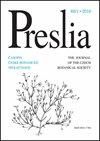中欧种Bolboschoenus的生态杂交种形成:遗传和形态评价
IF 2.9
2区 生物学
Q1 PLANT SCIENCES
引用次数: 9
摘要
众所周知,在许多分类群中,发散性自然选择促进了物种形成。苏柏属(Bolboschoenus)是研究生态学和同倍体杂交物种形成的一个模式群。Bolboschoenus有四个分类群分布在中欧:盐生B. maritimus和糖生B. laticarpus, planiculmis和B. yagara。这些物种的生态位不同。这种生态和/或地理隔离对同倍体杂交物种形成至关重要。根据花序的形态特征和瘦果的形态和解剖结构来确定其属。根据其中间形态、染色体数目和生态振幅,认为是杂交品种。以扩增片段长度多态性(aflp)作为分子标记,利用形态学数据对不同遗传类群进行了比较,以确定形态种的有效性和可能的杂交来源。确定了中欧种Bolboschoenus的形态分类。异种基因型植物也被发现是自发杂交的中间个体。研究了在遗传和形态上处于yagara和B. planiculmis之间的laticarpus的杂交起源。花序特征对物种的影响不如瘦果的解剖特征(外果皮和中果皮的宽度)。本文章由计算机程序翻译,如有差异,请以英文原文为准。
Ecological hybrid speciation in central-European species of Bolboschoenus: genetic and morphological evaluation
Divergent natural selection is known to facilitate speciation in many taxa. The genus Bolboschoenus (Cyperaceae) is a model group for investigating ecological and homoploid hybrid speciation. Four taxa of Bolboschoenus occur in central Europe: the halophyte B. maritimus and glycophytes B. laticarpus, B. planiculmis and B. yagara. These species differ in their ecological niches. Such ecological and/or geographical isolation is critical for homoploid hybrid speciation. The determination of species of Bolboschoenus is based on morphological characters of the inflorescence and on achene shape and anatomy. On the basis of its intermediate morphology, chromosome number and ecological amplitude B. laticarpus is thought to be a hybrid. In order to determine the validity of morphological species and the possible hybrid origin of B. laticarpus we used amplified fragment length polymorphisms (AFLPs) as molecular markers and compared different genetic groups defined using STRUCTURE analysis with morphological data. The morphological classification of central-European species of Bolboschoenus was confirmed. Plants of heterogeneous genotypes were also found to be intermediate individuals resulting from spontaneous hybridization. Hybrid origin of B. laticarpus, which is genetically and morphologically intermediate between B. yagara and B. planiculmis, was elucidated. Inflorescence characters were less important for determining species than anatomical characters of achenes (widths of the exocarp and mesocarp).
求助全文
通过发布文献求助,成功后即可免费获取论文全文。
去求助
来源期刊

Preslia
生物-植物科学
CiteScore
5.20
自引率
29.40%
发文量
8
审稿时长
>12 weeks
期刊介绍:
Preslia is a peer-reviewed scientific journal publishing original research papers on plant systematics, morphology, phytogeography, ecology and vegetation science, with a geographical focus on central Europe. The journal was founded in 1914 and named in honour of brothers Jan Svatopluk Presl (1791–1849) and Karel Bořivoj Presl (1794–1852), outstanding Bohemian botanists. It is published quarterly by the Czech Botanical Society.
 求助内容:
求助内容: 应助结果提醒方式:
应助结果提醒方式:


